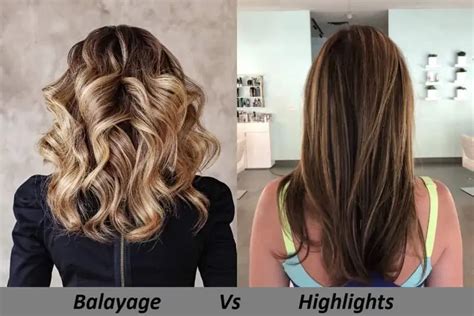1. Technique: The Stroke of Art
Balayage:

- Originating in France, balayage (“to sweep”) involves the freehand painting of lightener onto the hair, creating a soft, blended effect.
- The colorist uses a brush or comb to gently stroke the lightener onto specific sections of the hair, mimicking the natural fading caused by the sun.
Highlights:
- Highlights, on the other hand, employ a more precise approach, using foils or a cap to isolate and color individual strands of hair.
- This technique provides a more defined and contrasting result, creating noticeable streaks of color.
2. Blending: A Subtle or Striking Transition
Balayage:
- Balayage’s hallmark is its subtle and gradual blending, resulting in a natural-looking ombré effect.
- The smooth transitions between darker roots and lighter ends enhance the hair’s texture and depth, creating the illusion of effortless dimension.
Highlights:
- Highlights prioritize bolder, well-defined transitions between colored and non-colored hair.
- The thicker, more visible lines create a more striking and contrasting look, adding a noticeable pop of color to the hair.
3. Maintenance: Frequency of Touch-Ups
Balayage:
- Due to its seamlessly blended nature, balayage grows out gracefully, requiring less frequent touch-ups.
- The subtle transitions mean that regrowth is less noticeable, allowing for longer intervals between salon visits.
Highlights:
- Highlights typically require more frequent maintenance as the contrasting colors can quickly become obvious as the hair grows out.
- Touch-ups every 6-8 weeks are often necessary to maintain the desired brightness and prevent a harsh root line.
4. Damage: Minimizing Hair’s Distress
Balayage:
- Balayage’s freehand application allows for more targeted placement of lightener, minimizing unnecessary exposure to chemicals.
- The partial highlighting technique reduces the overall amount of bleach used, resulting in less damage to the hair.
Highlights:
- Highlights, by virtue of their more precise and isolated application, involve more direct exposure to bleach, which can lead to increased hair damage.
- The use of foils or a cap can also create tension and stress on the hair, potentially contributing to breakage.
5. Cost: Balancing Aesthetics and Budget
Balayage:
- Balayage’s labor-intensive nature generally translates to a higher cost compared to highlights.
- The freehand technique requires specialized skills and more time, driving up the price of the service.
Highlights:
- Highlights are typically more affordable than balayage due to the lower labor costs involved.
- The precise and formulaic application makes it a more time-efficient process, resulting in a lower price point.
6. Time Commitment: Hours in the Salon Chair
Balayage:
- Balayage’s meticulous application can take several hours, depending on the length and thickness of the hair.
- The freehand technique and careful blending require patience and precision, extending the time spent in the salon.
Highlights:
- Highlights, with their more streamlined application, generally take less time than balayage.
- The use of foils or a cap simplifies the process, reducing the overall time investment.
7. Personalization: Tailoring to Unique Looks
Balayage:
- Balayage empowers the colorist to create a truly bespoke look by customizing the placement, tone, and intensity of the lightener.
- The freehand application allows for the creation of unique patterns and effects, tailored to the client’s desired style.
Highlights:
- Highlights offer a wide range of color choices and thicknesses, allowing for personalization but within a more structured framework.
- The precise application provides more control over the placement and intensity of the color, ensuring consistency and accuracy.
| Feature | Balayage | Highlights |
|---|---|---|
| Technique | Freehand painting | Isolation using foils or cap |
| Blending | Subtle, natural transitions | Defined, contrasting lines |
| Maintenance | Less frequent touch-ups | More frequent touch-ups |
| Damage | Minimal hair damage | Potential for increased hair damage |
| Cost | Generally higher | Generally lower |
| Time Commitment | Lengthy application process | Shorter application process |
| Personalization | Highly customizable | Personalized within a structured framework |
Pros of Balayage:
- Natural-looking, blended effect
- Less frequent maintenance
- Minimal hair damage
- Customizable to unique styles
Cons of Balayage:
- Higher cost
- Lengthy application process
Pros of Highlights:
- Defined, contrasting color
- More affordable
- Shorter application process
- Wide range of color and thickness options
Cons of Highlights:
- More frequent maintenance
- Potential for increased hair damage
- Less customizable than balayage
Motivations for Balayage:
- Desire for a natural, sun-kissed look
- Low-maintenance hair color solution
- Customization to enhance unique looks
- Reduced hair damage
Pain Points for Balayage:
- Higher cost compared to highlights
- Lengthy application process
Motivations for Highlights:
- Bold, contrasting color effect
- More affordable option
- Shorter application process
- Wide range of color and thickness choices
Pain Points for Highlights:
- More frequent maintenance
- Potential for increased hair damage
- Less customizable than balayage
Beyond Traditional Uses:
- Balayage for men: Creating subtle dimension and texture in masculine hair
- Highlights for curly hair: Adding definition and volume without losing natural curls
- Balayage on dark hair: Achieving beautiful dimension and contrast without drastic bleaching
- Highlights on blonde hair: Enhancing natural highlights and creating a sunkissed glow
Emerging Trends:
- Reverse balayage: Darkening the ends of the hair while keeping the roots lighter
- Micro highlights: Tiny, subtle highlights for a barely-there effect
- Foilyage: Combining balayage and highlights for a customized, blended look
- Shatush balayage: A technique that creates a natural, sun-kissed gradient
The choice between balayage and highlights ultimately depends on individual preferences, lifestyle, and hair goals. Balayage offers a natural, blended look with less maintenance and hair damage, while highlights provide a bolder, contrasting effect at a more affordable price point. By understanding the key differences, motivations, and pain points associated with each technique, individuals can make an informed decision that aligns with their unique hair desires.
